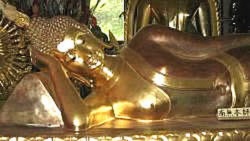Difference between revisions of "Hsin-hsing"
| (One intermediate revision by the same user not shown) | |||
| Line 10: | Line 10: | ||
<poem> | <poem> | ||
'''[[Hsin-hsing]]''' | '''[[Hsin-hsing]]''' | ||
| + | |||
[[信行]] (540–594) (PY [[Xinxing]]; Jpn [[Shingyo]]) | [[信行]] (540–594) (PY [[Xinxing]]; Jpn [[Shingyo]]) | ||
| − | Also known as the [[Meditation Master]] [[San-chieh]], or simply [[San-chieh]]. A [[priest]] who founded the | + | Also known as the [[Meditation Master]] [[San-chieh]], or simply [[San-chieh]]. A [[priest]] who founded the [[Three Stages]] ([[San-chieh-chiao]]) school in [[China]]. His {{Wiki|concept}} of the three stages was closely related to the [[three periods]] following |
| Line 25: | Line 26: | ||
and the [[Latter Day]], [[ten thousand years]]. | and the [[Latter Day]], [[ten thousand years]]. | ||
| − | Moreover, it was widely believed that the [[Latter Day]] had begun in the mid-sixth century.Hsin-hsing [[taught]] in a [[time]] that was considered the very beginning of the [[Latter Day]]. He maintained that his [[teaching]] was the [[teaching]] [[appropriate]] to the third stage, or the [[Latter Day of the Law]], when the people's capacity was most limited, and that only his [[teaching]], {{Wiki|being}} the most [[universal]], | + | Moreover, it was widely believed that the [[Latter Day]] had begun in the mid-sixth century.[[Hsin-hsing]] [[taught]] in a [[time]] that was considered the very beginning of the [[Latter Day]]. He maintained that his [[teaching]] was the [[teaching]] [[appropriate]] to the third stage, or the [[Latter Day of the Law]], when the people's capacity was most limited, and that only his [[teaching]], {{Wiki|being}} the most [[universal]], |
| Line 35: | Line 36: | ||
veneration before those they met. His [[teaching]] spread widely, but after his [[death]] the school was often persecuted because its [[doctrine]] and [[activities]] contradicted those of the earlier schools as well as government policy. It [[died]] out during the [[Sung dynasty]] (960-1279). | veneration before those they met. His [[teaching]] spread widely, but after his [[death]] the school was often persecuted because its [[doctrine]] and [[activities]] contradicted those of the earlier schools as well as government policy. It [[died]] out during the [[Sung dynasty]] (960-1279). | ||
| − | See also | + | See also [[Three Stages school]]. |
Latest revision as of 13:51, 26 December 2023
Hsin-hsing
信行 (540–594) (PY Xinxing; Jpn Shingyo)
Also known as the Meditation Master San-chieh, or simply San-chieh. A priest who founded the Three Stages (San-chieh-chiao) school in China. His concept of the three stages was closely related to the three periods following
Shakyamuni Buddha's death, i.e., the Former Day, the Middle Day, and the Latter Day of the Law. In China, from the end of the Northern and Southern Dynasties period (439-589) through the period of the Sui dynasty (581-618), discussions of the three periods prevailed with emphasis on the Latter Day of the Law.
The Former Day was believed to last five hundred years,
the Middle Day, a thousand years,
and the Latter Day, ten thousand years.
Moreover, it was widely believed that the Latter Day had begun in the mid-sixth century.Hsin-hsing taught in a time that was considered the very beginning of the Latter Day. He maintained that his teaching was the teaching appropriate to the third stage, or the Latter Day of the Law, when the people's capacity was most limited, and that only his teaching, being the most universal,
could save the people in that age. According to Hsin-hsing, during the first stage, or the Former Day of the Law, the one vehicle teaching was practiced; during the second stage, or the Middle Day of the Law, the three vehicle teaching was practiced; and during the third stage, or the Latter Day of the Law, his teaching would spread. Hsin-hsing taught that the people should direct
their faith and allegiance to all Buddhas and all teachings and also held that the Buddha nature was inherent in all living beings. Thus he and his followers looked upon the people as potential or future Buddhas, and as a practice prostrated themselves in
veneration before those they met. His teaching spread widely, but after his death the school was often persecuted because its doctrine and activities contradicted those of the earlier schools as well as government policy. It died out during the Sung dynasty (960-1279).
See also Three Stages school.
